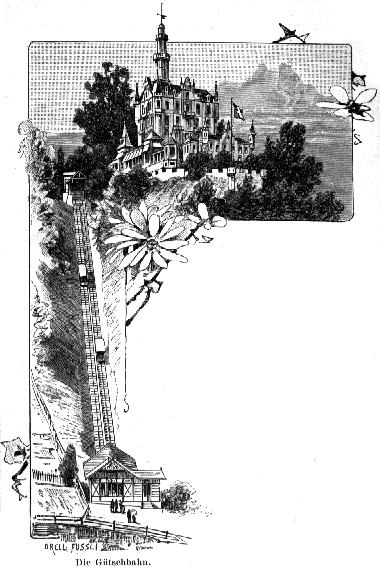Funicular
|
|
Angels_Flight.jpg
A funicular, also called funicular railway or inclined railway, inclined plane, or in the United Kingdom a cliff railway, consists of a system of transport in which cables attach to a tram-like vehicle on rails to move it up and down a very steep slope.
The word "funicular" derives from the Latin funiculus (thin rope), a diminutive of funis (rope).
| Contents |
Introduction
Funiculars are also called trams or cable cars in many places. Typically the steepness of the track does not vary very much, which differentiates the funicular from a cable railway. In addition, the cars of a funicular usually are permanently attached at the end(s) of the cable whereas the cars on a cable railway can usually detach and reattach to the cable during normal operation. The vehicle is often specially designed for the particular inclination, so that seats and/or floors remain roughly horizontal.
It is thus a hybrid between cable transport and rail transport. Two cars at the end of a cable go alternately up and down on either two tracks or one track which splits and rejoins in the middle. Funiculars often occur in mountains. Many cities have short funiculars on hills or cliffs, such as the Montmartre funicular in Paris, or those in the English seaside resort of Scarborough.
Some urban funiculars are associated with a city's transit system. For example, the Montmartre funicular in Paris and the Montjuïc funicular in Barcelona are fare-integrated with those cities' metro systems.
The world's steepest passenger railway is the Katoomba Scenic Railway, a funicular down the wall of the Jamison Valley near Katoomba, New South Wales, Australia, with maximum grade of 122% (52° from horizontal, 90° being vertical). [1] (http://infobluemountains.net.au/rail/ksr/Default.htm)
Duquesne_incline.jpg
History
The earliest such railways were water-driven, allowing barge traffic of canals to ascend and descend steep hills. They were used primarily in the early 19th century, especially during the height of the canal-building era in the 1830s in the United States.
Such railways operated by allowing water in feeder canals at the top of the plane to drive a turbine, raising or lowering a canal barge along a steep slope. Along level sections, the railroads essentially operated as standard towpath canals, with the barges typically drawn by horse or mule.
Examples of hydropower inclined plane railroads in the United States included the Allegheny Portage Railroad, part of the Pennsylvania Main Line Canal, built in 1834 with ten planes as the first railroad across the Allegheny Mountains of Pennsylvania. Similarly, the Morris Canal in New Jersey connected the Delaware River with the Passaic River using 23 planes, as well as a series of locks along the gentler gradients.
DocksideFunicular.jpg
ChongqingFunicular2.jpg
One of the most famous funiculars of its time was the Mount Lowe railway in Southern California, combing a funicular raising passengers 3,500 up the side of Mount Lowe with a trolley that plied tracks built around the edges of the mountain, finally depositing tourists at the Alpine Inn, only 1,100 feet from the mountain's summit. The railway was built at the turn of the twentieth century, but it was gone by 1938, lost after a fire destroyed the Alpine Inn.
Funiculars of the world
The steepest funicular in the world is the Incline Railway at the Royal Gorge near Cañon City, Colorado, with a grade of 100% set at a 45 degree angle and 1,550 feet (473 meters) long.
- Aberystwyth Electric Cliff Railway, Aberystwyth, Wales
- Allegheny Portage Railroad, Gallitzin, Pennsylvania, USA (Historic Funicular site)
- Angels Flight, Los Angeles, California, United States "The shortest railway in the world"
- Fløibanen, Bergen, Norway
- Bridgnorth Cliff Railway, UK.
- Budapest, Hungary
- Cairn Gorm mountain funicular, Scotland
- Capri, Italy
- Chattanooga, Tennessee, USA, the Incline Railway on Lookout Mountain
- Chongqing, China, for transport of riverboat passengers from pontoon to shore.
- Dresden Standseilbahn, Germany
- Duquesne Incline and Monongahela Incline, Pittsburgh, Pennsylvania, United States, USA
- Falls Incline, Niagara Falls, Canada
- Fourth Street Elevator, Dubuque, IA (also called the Fenelon Place Elevator)
- Fribourg, Switzerland
- Folkestone, England (water-powered)
- Genoa, Italy
- Graz, Austria
- Guanajuato, Mexico
- Gütschbahn, Lucerne, Switzerland
- Hastings, England
- Harderbahn, Interlaken, Switzerland
- Haifa, Israel (the Carmelit, underground)
- Heidelberg, Germany, Königstuhlbahn
- Hong Kong Victoria Peak - Peak Tram
- Horseshoe Curve, Altoona, Pennsylvania, Pennsylvania, USA (Run as part of the tourist attaction)
- Istanbul, Turkey (the Tunel, underground)
- Johnstown Inclined Plane, Johnstown, Pennsylvania, USA
- Katoomba Scenic Railway, Katoomba, New South Wales, Australia
- Karlovy vary, Czech Republic
- Lake Como, Lombardy, Italy up to Brunate
- Lisbon, Portugal, built on seven hills, is served by three small funiculars
- Llandudno, Wales, the Great Orme Tramway
- Lykavittos, Athens
- Lyon, France (first funicular of the world, 1860)
- Marzilibahn, Bern, Switzerland
- Mendelbahn, South Tyrol, Italy, built in 1903
- Montecatini, Italy
- Montjuïc, Barcelona
- Monserrate (hill), Bogotá, Colombia
- Montserrat (mountain), Catalonia
- Montmartre, Paris, France
- Naples, Italy
- Nazaré, Portugal
- Penang, Malaysia
- Prague, Czech Republic
- Royal Gorge, Cañon City, Colorado, United States
- Quebec City
- Tibidabo, Barcelona
- Tignes (Grande Motte glacier), France
- Vallvidrera, Barcelona
- Valparaiso, Chile
- Viana do Castelo, Portugal
- Wat Phra That Doi Suthep, Chiang Mai, Thailand
- Wellington, New Zealand (Wellington Cable Car)
- Wiesbaden, Germany (using water as weight to move the cars)
- Zagreb, Croatia
See also: List of funiculars in the United Kingdom, List of funiculars in Switzerland
External links
- Funimag, the first web magazine about funiculars (http://www.funimag.com)
- Urban Mountain Railways and People Movers (http://www.p.lodz.pl/I35/personal/jw37/urbtr/funicul-eng.html)
- Fløibanen funicular in Bergen (http://www.floibanen.no/eng/)
- Elevador da Gloria in Lisbon, Portugal (http://www.photo.net/photodb/photo?topic_id=1481&msg_id=00A1se&photo_id=2858961)
- Wellington Cable Car, New Zealand (http://www.wellingtonnz.com/cablecar/)
- Funicular in Québec City, Canada (http://www.funiculaire-quebec.com/)

